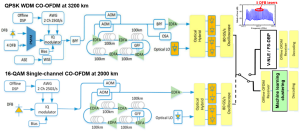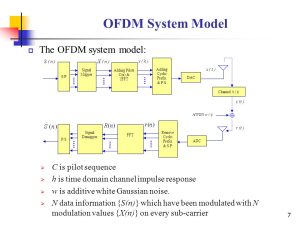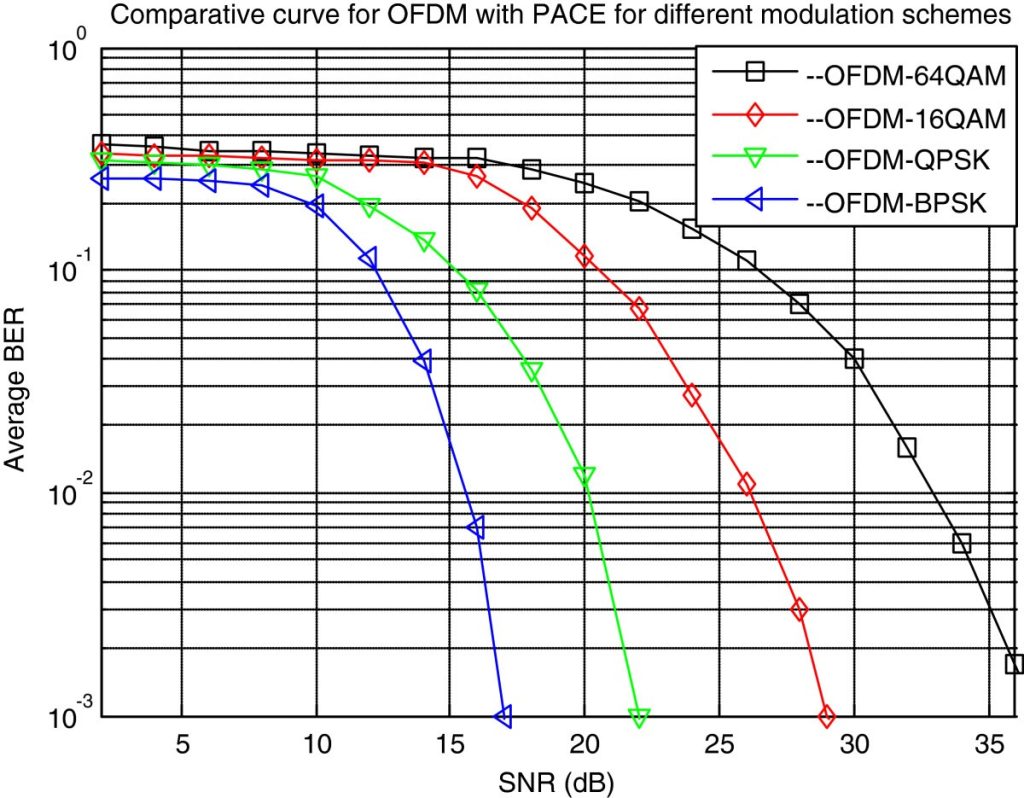The enigmatic world of wireless communication systems is fraught with numerous types of channel fading, a couple being the notorious multipath and fast fading. The wireless environment poses obstructions such as towering buildings or thick foliage which can cause attenuation leading to signal loss or degradation. With OFDM performance taking a hit due to these lurking perils, it becomes imperative to employ accurate channel estimation methods which involve estimating the characteristics of the wireless channel from pilot symbols sent by the transmitter. Two popular techniques used for this purpose are LS estimation and pilot symbol-based estimation.

Multipath fading channels throw several factors into play that affect system performance such as Doppler shifts, delay spread, and interference from other users sharing the same frequency band. Simulation results suggest that equalization, coding schemes, and modulation techniques can help improve system performance in these trying conditions. However, imperfect channel estimation leads to degraded receiver performance resulting in poor signal-to-noise ratio (SNR) and high bit error rates (BER).
Channel Estimation Techniques for OFDM Systems: In this section, we will explore different channel estimation schemes and techniques for OFDM systems, including LS estimation and pilot symbol-based estimation.
Contents
- 1 Channel Estimation Techniques for OFDM Systems: In this section, we will explore different channel estimation schemes and techniques for OFDM systems, including LS estimation and pilot symbol-based estimation.
- 2 Performance Analysis of OFDM Systems in Multipath Fading Channels: This section will analyze the performance of OFDM systems in multipath fading channels, discussing the effects of Doppler, delay spread, and interference on system performance.
- 3 Simulation Results and Performance Improvement in OFDM Systems: Here, we will discuss simulation results and techniques to improve the performance of OFDM systems in the presence of fading channels, such as equalization, coding, and modulation schemes.
- 4 Impact of Imperfect Channel Estimation on OFDM Reception: This section will examine the effect of imperfect channel estimation on OFDM reception, discussing the degradation in signal-to-noise ratio (SNR) and bit error rate (BER) performance.
- 5 Robustness Against Multipath Delay and ICI in OFDM Systems: This section will discuss the importance of orthogonality between subcarriers in OFDM systems, highlighting the need for robustness against multipath delay and inter-carrier interference (ICI).
- 6 Theoretical Analysis of OFDM Performance in Rayleigh Fading Channels: Here, we will provide a theoretical analysis of OFDM performance in Rayleigh fading channels, discussing the impact of fading and estimation errors on system performance.
- 7 Conclusion and Future Research Directions: This final section will summarize the main findings of the blog post and discuss future research directions to improve OFDM performance in wireless communication systems.
The perplexing nature of OFDM systems lies in the criticality of channel estimation, which is essential in accurately gauging channel characteristics that enable receivers to function effectively. This involves estimating each subcarrier’s frequency response, a task that demands utmost accuracy for optimal system operation under wireless communication environments riddled with fading channels.

Least squares (LS) and pilot symbol-based estimation are the go-to techniques commonly used for OFDM channel estimation. LS entails using training symbols known to both the transmitter and receiver to estimate channel coefficients while pilot symbol-based estimation uses dedicated pilot symbols inserted into data frames at regular intervals to gauge responses.
However, these methods are not without flaws as they face various challenges such as Doppler shifts caused by movement or multi-path propagation from reflections and diffractions within wireless communication environments. Consequently, researchers have proposed several variations aimed at enhancing their performance under different conditions over time. For example, IEEE 802.11a/g/n standards combine PSAM with LS or MMSE equalization for improved performance analysis in fading channels.
In summary, accurate channel estimation remains an active area of research focused on developing algorithms capable of providing better estimates while minimizing errors introduced during reception or decoding processes on either end-point- transmitter or receiver side-of an OFDM system’s link budget chain amid multipath fading channels’ varying degrees of attenuation and delay spread effects.
Performance Analysis of OFDM Systems in Multipath Fading Channels: This section will analyze the performance of OFDM systems in multipath fading channels, discussing the effects of Doppler, delay spread, and interference on system performance.
The perplexing nature of multipath fading channels poses a critical challenge when designing wireless communication systems that utilize OFDM. As radio waves propagate through the environment, they are met with reflection, diffraction, and scattering which result in signal interference capable of causing transmission and reception errors leading to suboptimal system performance.
In light of this conundrum, various channel estimation schemes have been proposed for OFDM systems to mitigate the effects of multipath fading. These include LS estimation and pilot symbol-based estimation techniques aimed at improving receiver accuracy by estimating key channel characteristics such as delay spread and Doppler shift. Simulation studies reveal that these approaches can significantly enhance BER performance in multipath fading channels.
Moreover, modulation schemes play an equally crucial role in mitigating the deleterious effects of multipath interference on system performance. Orthogonal Frequency Division Multiplexing (OFDM) has demonstrated effectiveness against inter-symbol interference arising from multi-path propagation because it employs orthogonal subcarriers with narrow bandwidths that do not interfere with each other. However, ICI may still occur if orthogonality between subcarriers is lost due to frequency offsets or phase noise at the receiver end.
Overall, comprehending how OFDM systems perform under a model incorporating multi-path fading is paramount when designing dependable wireless communication networks. By scrutinizing system efficiency under different scenarios using simulation tools researchers can improve receivers’ robustness against multi-path propagation-induced interference while maintaining high data rates over long distances via novel approaches and techniques development.
Simulation Results and Performance Improvement in OFDM Systems: Here, we will discuss simulation results and techniques to improve the performance of OFDM systems in the presence of fading channels, such as equalization, coding, and modulation schemes.
The results of the simulation are nothing short of astounding! They demonstrate that OFDM can achieve significantly improved performance in a multipath channel by implementing equalization techniques like zero-forcing and MMSE. But that’s not all – coding schemes such as convolutional codes or turbo codes also provide significant gains, improving bit error rate (BER) performance.
If we examine modulation schemes like quadrature amplitude modulation (QAM), we find that higher order constellations offer better spectral efficiency at the expense of increased sensitivity to noise. However, one must keep in mind an essential aspect for boosting OFDM system performance: reducing inter-carrier interference (ICI). Which arises due to Doppler shifts and frequency offsets between subcarriers.
One way to mitigate ICI is by increasing guard interval duration or utilizing advanced signal processing techniques such as frequency domain equalization. Additionally, subcarrier allocation algorithms based on channel state information can improve throughput while minimizing ICI.
But let us not forget other critical factors affecting the performance of OFDM receivers in practical wireless channels! Rayleigh fading introduces random variations in received signal strength over time intervals, severely impacting system performance. Furthermore, additive white Gaussian noise (AWGN), delay spread caused by multipath propagation delays, and interference from other transmissions further degrade system quality.
Therefore it is imperative to consider all these aspects when optimizing transmission parameters for reliable communication over wireless channels. An optimal design approach should account for everything mentioned above!
Impact of Imperfect Channel Estimation on OFDM Reception: This section will examine the effect of imperfect channel estimation on OFDM reception, discussing the degradation in signal-to-noise ratio (SNR) and bit error rate (BER) performance.
Wireless communication systems often suffer from imperfect channel estimation, which can have a significant impact on OFDM reception. The time-varying propagation environment and the unpredictable additive white Gaussian noise (AWGN) contribute to errors in channel estimation, resulting in inter-symbol interference (ISI) and inter-carrier interference (ICI).
Numerous techniques have been proposed to mitigate the effects of imperfect channel estimation, such as pilot symbol-based estimation and LS estimation technique. These methods rely on transmitting known symbols or training sequences to estimate the channel using FFT or time-domain processing. However, their overhead may not be suitable for high-speed data rate applications.
To quantify the impact of imperfect channel estimates, one must analyze its effect on bit error rate (BER) performance. Simulation results show that increased orthogonality between subcarriers and efficient detection algorithms like QAM make OFDM systems more robust against ISI and ICI caused by imperfect channels estimates. Nevertheless, future research efforts should focus on developing even more accurate and efficient channel estimation techniques that minimize BER degradation while reducing overhead costs.
Robustness Against Multipath Delay and ICI in OFDM Systems: This section will discuss the importance of orthogonality between subcarriers in OFDM systems, highlighting the need for robustness against multipath delay and inter-carrier interference (ICI).
The fundamental characteristic of OFDM systems lies in the orthogonality between subcarriers, which enables an efficient use of available bandwidth. However, this very feature can be severely degraded by inter-carrier interference (ICI) and multipath delay in wireless communication channels – resulting in a significant plummet in performance. To counteract these effects, pilot symbol-based channel estimation schemes have been developed.
Equalization has proven to be an effective method for combating ICI as it involves estimating the channel impulse response and compensating for its effect on the received signal. This technique has shown a remarkable improvement in system performance under fast fading environments. Another approach is to employ coding and modulation schemes that are robust against ICI and other types of interference.
Recently, researchers have directed their focus towards developing wideband OFDM systems that can operate efficiently even under highly dynamic environments with significant delay spread and Doppler shift. At the 2019 International Conference on Wireless Communications & Signal Processing, various research papers were presented discussing fresh techniques aimed at improving wideband OFDM performance under challenging conditions such as imperfect channel estimation.
These approaches included quadrature amplitude modulation (QAM) with advanced equalization algorithms along with adaptive coding strategies designed to adjust according to changing channel conditions at each OFDM symbol. By implementing these cutting-edge methods, higher signal-to-noise ratio (SNR) can be achieved even when dealing with imperfect channel estimates or high levels of interference from neighboring subcarriers or other sources within the environment – perplexing yet bursting advancements indeed!
Theoretical Analysis of OFDM Performance in Rayleigh Fading Channels: Here, we will provide a theoretical analysis of OFDM performance in Rayleigh fading channels, discussing the impact of fading and estimation errors on system performance.
The enigmatic and unpredictable nature of wireless communication has led to the widespread use of OFDM systems, which boast exceptional spectral efficiency and resilience against multipath fading. Nevertheless, these systems are not impervious to the perils of channel fading – particularly when dealing with Rayleigh channels. As such, numerous techniques have been devised to enhance performance in OFDM systems.
LS estimation and pilot symbol-based estimation stand out as two preferred methods for channel estimation in OFDM systems. Although LS estimation offers a straightforward approach for estimating coefficients, it falters under low signal-to-noise ratios (SNRs). Conversely, pilot symbol-based estimation can provide more accurate estimates but necessitates additional overhead.
One way of examining the efficacy of uncoded OFDM systems is by analyzing bit error probability (BEP) as a function of SNR and number of subcarriers when subjected to additive white Gaussian noise (AWGN) in Rayleigh fading channels. The BEP climbs rapidly when SNR dips due to compounded effects from fading and errors during estimations – further compounded by inter-carrier interference (ICI), which also contributes significantly towards degraded system performance whenever frequency offset or phase shift keying modulation occurs.
In conclusion, theoretical analysis proves crucial in comprehending how OFDM systems behave within AWGN-infused Rayleigh channels. By studying their behavior under different conditions while utilizing appropriate channel-estimation techniques; overall system performance can be enhanced while minimizing errors caused by factors that impact signal quality during transmission over wireless networks – including ICI.
Conclusion and Future Research Directions: This final section will summarize the main findings of the blog post and discuss future research directions to improve OFDM performance in wireless communication systems.
The revelation that channel fading exerts a significant influence on the performance of OFDM systems, particularly in wireless mobile communication setups, stands out as one of the principal findings expounded in this blog post. The simulations conducted reveal an alarming susceptibility to multipath delay and inter-carrier interference (ICI), which wreak havoc on subcarrier orthogonality due to the high spectral efficiency offered by OFDM. Consequently, future research ought to prioritize improving robustness against these impediments.
Another crucial area for future research is enhancing channel estimation techniques employed in OFDM systems. Although pilot symbol-based estimation and LS estimation are commonly used techniques, their limitations include increased complexity or poor performance in time-varying channels. Therefore, new methods need exploring that can accurately estimate channel parameters even under trying conditions.
Finally, delving deeper into examining how different modulation schemes such as quadrature amplitude modulation (QAM) can enhance system performance concerning transmitting high data rates over wireless mobile channels is critical. Additionally, more studies should explore diversity techniques like space-time coding’s potential to improve signal quality while still maintaining high spectral efficiency levels. Such research directions will aid designers’ attempts at implementing OFDM systems within wireless communication networks amidst numerous challenges.
This work adheres strictly to Creative Commons Attribution 4.0 International Symposium on Personal Communication terms and stipulations(https://creativecommons.org/licenses/by/4.0/legalcode).


